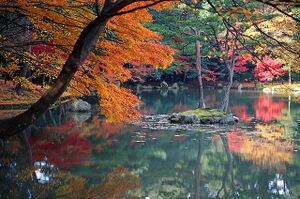
 Revealed: the huge climate impact of the middle classes, theguardian.com (Nov 20, 2023)
Revealed: the huge climate impact of the middle classes, theguardian.com (Nov 20, 2023)
Networks and sustainability initiatives[edit | edit source]
Events[edit | edit source]
Regular events: Japan Green Drinks, listings for 5 cities
Ecovillages[edit | edit source]
Konohana Family, Japan, link updated 11:43, 8 September 2022 (UTC)
Climate action[edit | edit source]
Biodiversity[edit | edit source]
Trees, woodland and forest[edit | edit source]
Community energy[edit | edit source]
Fukushima Community Power Declaration
Ethical consumerism[edit | edit source]
Food activism[edit | edit source]
Solar cooking resources in Japan
Reduce, reuse, repair and recycle[edit | edit source]
Recycling in Japan - Kamikatsu waste management
Sustainable transport activism[edit | edit source]
Urban sustainability[edit | edit source]
ACROS Fukuoka building - Tokyo DIY Gardening, Hands-on gardening for a crowded city
Resources[edit | edit source]
Citizens data initiative[edit | edit source]
Other resources[edit | edit source]
- Just Enough lessons in living green from traditional Japan - Review requested
- Translation of transition materials
Near you[edit | edit source]
About Japan[edit | edit source]
Japan is an island country in East Asia. It is in the northwest Pacific Ocean and is bordered on the west by the Sea of Japan, extending from the Sea of Okhotsk in the north toward the East China Sea, Philippine Sea, and Taiwan in the south. Japan is a part of the Ring of Fire, and spans an archipelago of 14,125 islands, with the five main islands being Hokkaido, Honshu (the "mainland"), Shikoku, Kyushu, and Okinawa. Tokyo is the country's capital and largest city, followed by Yokohama, Osaka, Nagoya, Sapporo, Fukuoka, Kobe, and Kyoto.
The Japanese archipelago has been inhabited since the Upper Paleolithic (30,000 BC). Between the fourth and ninth centuries AD, the kingdoms of the region became unified under an emperor and the imperial court based in Heian-kyō. Beginning in the 12th century, political power was held by a series of military dictators (shōgun) and feudal lords (daimyō), and enforced by a class of warrior nobility (samurai). After a century-long period of civil war, the country was reunified in 1603 under the Tokugawa shogunate, which enacted an isolationist foreign policy. In 1854, a United States fleet forced Japan to open trade to the West, which led to the end of the shogunate and the restoration of imperial power in 1868. In the Meiji period, the Empire of Japan adopted a Western-modeled constitution, and pursued a program of industrialization and modernization. Amidst a rise in militarism and overseas colonization, Japan invaded China in 1937 and entered World War II as an Axis power in 1941. After suffering defeat in the Pacific War and two atomic bombings, Japan surrendered in 1945 and came under a seven-year Allied occupation, during which it adopted a new constitution.


